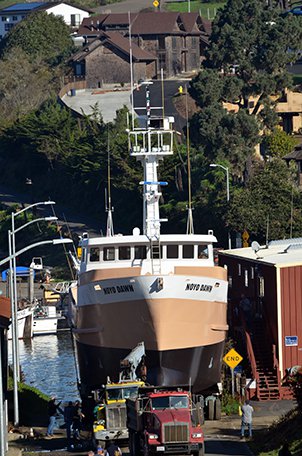In good hands
A torch is passed with the launch of a new multispecies trawler and crabber at Van Peer Boatworks in California
There’s new energy coming out of the California seaside town of Fort Bragg, long known as a commercial fishing haven north of San Francisco. As one of only four Golden State harbors north of the Bay Area, it’s an important point of departure for finfish and crab boats.
The Noyo River, which makes its way from the Pacific Ocean through the south side of the town, is home to around 80 commercial fishing boats made up of salmon trollers, groundfish trawlers, sea urchin dive boats and multispecies vessels. This fleet just expanded by an order of one, and this new boat is home grown.
Keeping a boat built and owned by locals in Fort Bragg is quite a big deal in this small, close-knit town that turned out to witness the launch of the new trawler Noyo Dawn on Nov. 15, 2016, in a strong showing of community support. At Van Peer Boatworks, owner Chris Van Peer says he’s been building boats for nearly 43 years — the Noyo Dawn is the 33rd boat he’s built — and all but a few went somewhere else.
The demand for steel Van Peer boats, well known in part for their durability, may be one reason they have found owners to the north. The Noyo Dawn was ordered nearly two years before launch. She took 22 months to build from design by Jensen Maritime Consultants in Seattle to her launch at home. At press time, she was performing sea trials to work the nits out before the season.
Tom Estes, who ordered the boat, is turning the helm of the Noyo Dawn to his son, also named Tom, and is very confident in his abilities. After showing a great interest in the trade, the junior Tom ran the family-owned Tara Dawn for the past 12 years.
A little shorter at 62' x 19', the Tara Dawn is a 40-year-old steel boat powered by a Cummins 600-hp with two auxiliary generators. This boat has been sold but will remain in service, and the Noyo Dawn at 66' x 24' 6" will become the replacement vessel.
It too will be powered by a Cummins, but a bit larger, and with Tier III emissions. The new turbo diesel will produce 750 horsepower mated to a 6:1 Twin Disc reduction gear.
“It looks like the same engine,” said Estes. “But it adds 150 hp and has the modern computer and emissions. We’ve had good luck with the Cummins and decided to use them again.” The engine was supplied by Gary Lancaster of Fort Bragg Diesel, which will also supply service and parts.
The two John Deere gensets were sourced from Western Power Products and are not quite twins, but close. The first unit is a four-cylinder 100-kW powerplant, and the second is a little larger, at 150 kW. That one, however, is a six-cylinder block...
Read full article in our February issue page 22.
» Read more Cover Stories here.
» Read more articles in our February issue.
» Fish eNews offers the latestindustry news.
» Like us on Facebook.
Copyright © 2017 National Fisherman. All rights reserved.







